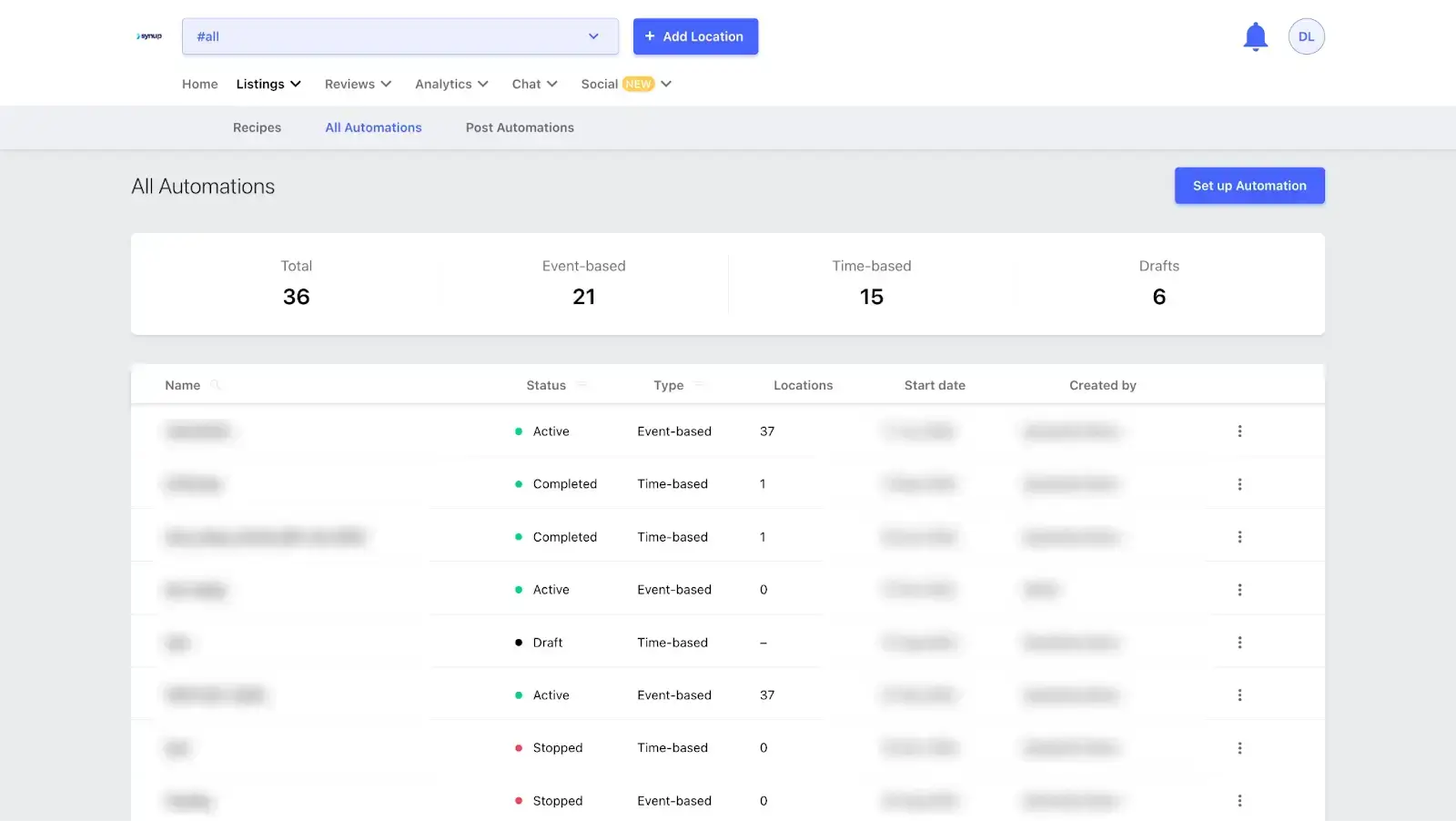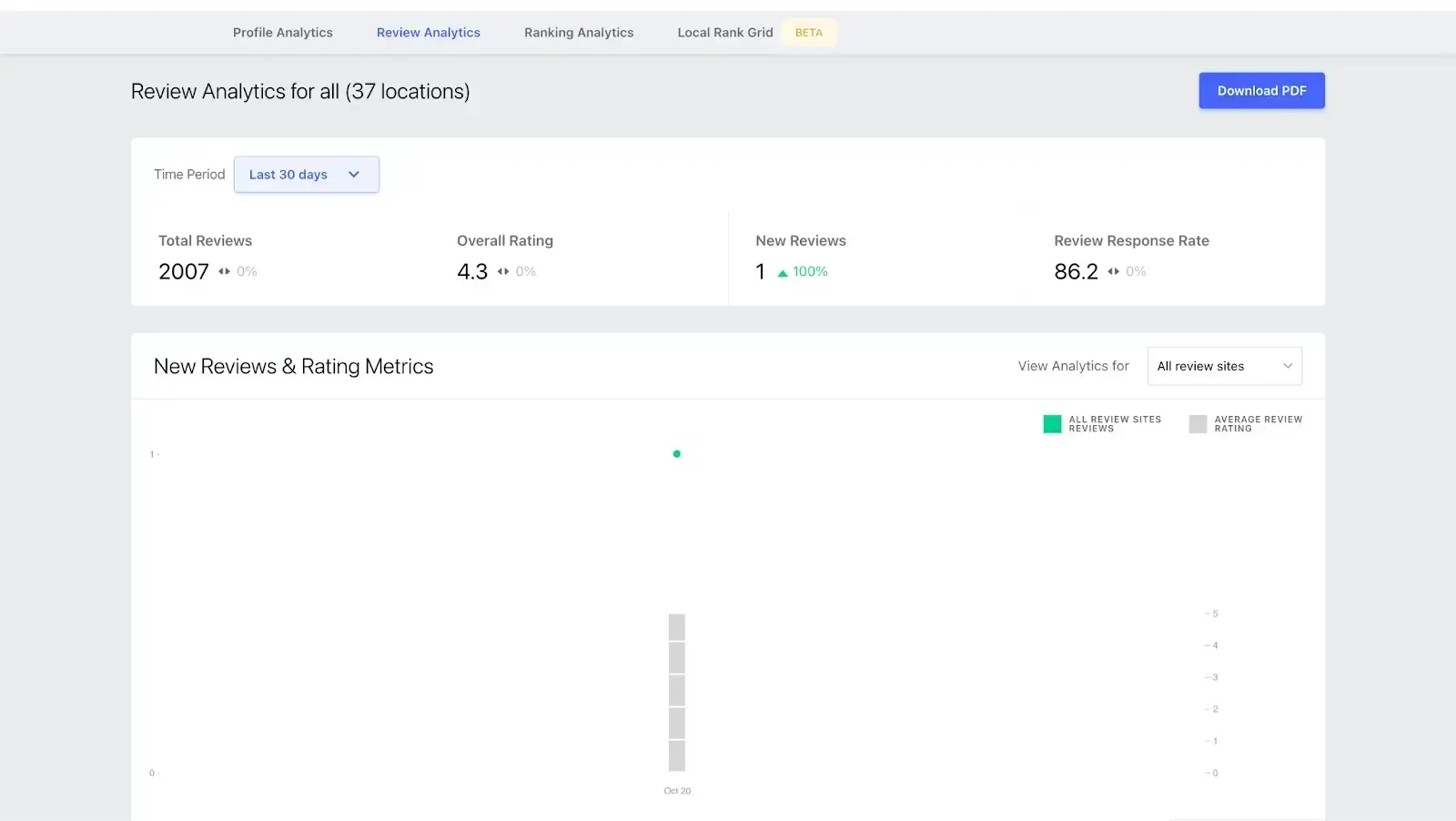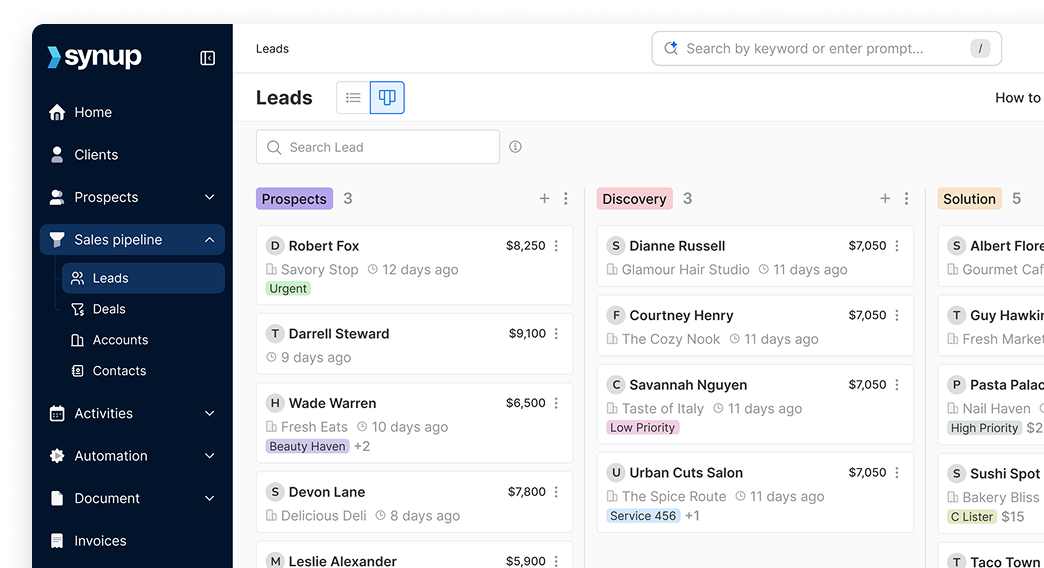Calculate the ROI of your local listing management software
Find out how to calculate the ROI of your local listing management software by tracking visibility, leads, and engagement to see if it’s really paying off

Return on Investment (ROI) measures how much profit or value an investment generates compared to its cost. When it comes to local listing management software, ROI plays an important role in showing whether the tool truly contributes to business goals.
For businesses that rely heavily on a local presence, such as retail chains, restaurants, or service providers - accurate and consistent listings directly impact their online visibility and the revenue they generate.
A well-managed listing helps your business appear in relevant local searches, maps, and directories. The more visibility there is, the better the foot traffic.
It also helps build trust with local customers and potential buyers who are looking for similar services to yours. On the other hand, incomplete or inaccurate listings can result in lost opportunities, lower rankings, and customer frustration. In the long run, the right local listing software pays off by reducing manual effort, keeping your customers informed, and ensuring that every search or inquiry leads to the right place, ultimately turning visibility into revenue.
Why ROI Matters in Local Listing Management
Return on Investment (ROI) is more than just a financial metric, it’s a way for businesses to see if the tools and strategies they’re using are worth the effort. With local SEO playing a bigger role in how customers find businesses, tracking ROI on local listing management is important. It helps companies make smarter decisions, get the most value from their software, and grow sustainably.
Here’s why ROI matters and how it can guide your business in the right direction.

1. Optimize Marketing Spend
Businesses need to know if their marketing budget is being spent wisely. Local listing management software should align with specific goals, like improving online visibility or increasing foot traffic. If the ROI data shows that these goals aren’t being met, it becomes clear where adjustments are needed.
For example, you might decide to prioritize listings on certain platforms or shift resources toward features that bring you much more engagement, like Google Business Profile optimization.
In such a case, Tracking ROI helps businesses avoid wasting time and money on efforts that aren’t working and double down on what’s delivering results. This helps ensure that every marketing dollar is used efficiently and keeps the business focused and on track with things that are required.

2. Improves Performance
Local listing tools often offer multiple features, from automated updates to multi-location management and real-time reporting. But not every feature may add significant value to your business. Analyzing ROI gives clarity on which parts of the software are actually generating real results.
For instance, if the data shows that automated updates are saving hours of manual work and keeping information accurate across platforms, you’ll know that’s an area worth spending further on.
ROI analysis also identifies bottlenecks in your business. If certain listings aren’t generating visibility or engagement, it might point to incorrect information or the need to optimize keywords for better local SEO. This helps businesses further refine their strategies and eliminate inefficiencies if any.

3. Supports Business Growth
ROI data makes it easier to justify software investments to stakeholders. When decision-makers can see measurable returns like improved search rankings, higher customer engagement, or increased foot traffic, it helps build confidence that the business is on the right path. Clear ROI metrics also pave the way for scaling efforts.
For example, you can use positive results to expand listings to more locations or invest in additional features, knowing they will add value.
Moreover, ROI plays a key role in long-term growth. As your business grows and scales, the insights gathered from ROI analysis guide you on where to focus your efforts next. Whether it’s adding new platforms to your listing strategy or introducing new customer engagement tools, ROI provides the data to back those decisions.

4. Why Accuracy and Visibility Matter
Local listing management isn’t just about showing up on Google, it’s about creating a seamless customer experience. Accurate and consistent information such as operating hours, phone numbers, and addresses helps businesses make sure that customers can easily find and trust your business.
A smooth, frustration-free experience encourages more foot traffic and builds long-term loyalty.
At the same time, accurate listings improve search engine visibility. Google and other platforms prioritize businesses with consistent information, which directly impacts local SEO.
Better visibility also means that your business appears higher in search results when customers are actively looking for your services. This not only drives engagement but also builds your reputation, leading to more positive reviews and better brand perception.

5. Reputation and Growth
Another often overlooked benefit of tracking ROI is its impact on reputation management. A good listing tool helps businesses respond to customer reviews quickly and stay on top of online sentiment.
Positive reviews often help you drive more business while responding to negative feedback shows that your company cares about customer experience. With ROI analysis, you can track how these efforts contribute to your business growth and help provide a much more comprehensive view of the software’s value.
Ultimately, ROI isn’t just about measuring dollars and cents, it’s about understanding how every aspect of your local listing management helps with visibility, engagement, and revenue.
It helps you make better decisions, improve your strategies, and scale confidently.
With local SEO becoming increasingly competitive, tracking ROI ensures your business stays ahead and continues to grow.
Important metrics to measure for ROI calculation
When evaluating the return on investment (ROI) from your local listing management software, it's essential to focus on metrics that align with your business goals. Monitoring these metrics will help you understand whether the tool helps with visibility, improves customer engagement, and reduces your operational costs.
Here’s a detailed breakdown of the key metrics to track:
1. Traffic Metrics
The first step is to track how your listings impact both online visibility and physical store visits. These metrics help you measure whether more people are seeing or interacting with your business, and most importantly, your content.
- Google My Business (GMB) Views: This tells you how often your GMB profile shows up when people search for relevant businesses. If your views are trending up, that’s a good sign your visibility is improving.
- Local Search Impressions and Clicks: Impressions show how often your business listing appears in local searches. Meanwhile, clicks give you an idea of how many people interact with your listing, whether it's clicking on the address, phone number, or website link. The more clicks, the more engagement you're driving.
- Website Visits from Local Listings: Tracking how many people visit your website through your listings gives insight into how well your local profiles are working. The goal here is to convert those views into meaningful site traffic and, eventually, leads or sales.
- Foot Traffic Attributed to Listing Tools: Some platforms offer insights into how many customers are finding your physical store through listings. Google Maps, for example, shows visit data that can hint at how well your listings are driving in-store traffic. If your tool provides similar data, it’s a great way to measure offline ROI.
2. Customer Engagement and Reviews
Reviews are important to build trust with potential customers and can directly impact your business's reputation. Tracking your engagement and feedback trends will help you gauge your progress in managing your customer relationships.
- Review Volume and Sentiment Analysis: Monitor the number of reviews your business receives and analyze their sentiment (positive, neutral, or negative). Sentiment analysis helps you understand customer perception and identify areas for improvement.
- Increased Review Responses: Engaging with customer reviews, both positive and negative, shows that you care about feedback. Keep track of the number of responses to ensure consistent engagement with your audience.
- Improved Star Ratings and Customer Feedback Trends: A higher average star rating reflects customer satisfaction while tracking feedback over time helps you identify emerging patterns. This insight can guide your efforts to improve services and customer experience.
3. Operational Savings
Local listing management tools often automate tasks that would otherwise require manual work. Tracking operational savings further helps you measure how efficiently the software streamlines your processes.
- Time Saved through Automation: Automation reduces the time spent on repetitive tasks like updating listings across multiple platforms. Track the hours saved to see the impact on your team’s productivity.
- Reduction in Manual Listing Errors: Inconsistent information across platforms can confuse customers and hurt your reputation. The software ensures uniform listings, reducing the chances of manual errors.
- Lower Costs of Managing Multiple Platforms: Managing listings on various platforms manually can be expensive, especially if you need to hire additional resources. Listing tools centralize this process, cutting down costs and eliminating the need for third-party services.
Steps to Calculate the ROI of Local Listing Management Software
Calculating the ROI of your local listing management software might seem like a task, but breaking it down into simple steps makes it easier. Let’s walk through the process, covering both the investment and the returns.
1. Subscription Costs (Monthly or Annual Fees)
Most listing management platforms charge either a monthly or annual subscription fee, which gives you access to the software’s features. These fees can vary based on:
- The number of locations you manage
- The features you unlock (some platforms offer premium tiers with advanced tools)
- Payment structure (some providers offer discounts for annual subscriptions)
For example, if you manage listings for multiple branches, your subscription cost might increase accordingly. You’ll need to decide whether a monthly or annual plan makes the most sense based on your budget and cash flow.
2. Setup and Onboarding Fees
Some software providers charge an initial setup or onboarding fee, especially if they offer personalized assistance with integrating the software into your workflow.
This could include:
- Migrating existing listings to the platform
- Customizing the software to fit your specific needs
- Connecting your accounts (like Google Business Profile, Yelp, and Bing)
This one-time cost helps ensure the software runs smoothly from day one, minimizing any disruptions.
3. Training Expenses
Even the best software comes with a learning curve. You’ll likely need to invest time and resources to train your employees so they can fully leverage all the platform’s features. Training costs can include:
- Time spent attending demos or training sessions
- External trainers or consultants, if needed
- Resources like instructional videos, manuals, or internal workshops
This step ensures that your team knows how to use the tool efficiently—maximizing the value you get from the software. Even if the platform offers great automation features, without proper training, your staff might underutilize it.
4. Internal Labor Costs (Employee Time)
Managing and maintaining listings through the software requires employee time, which translates into labor costs. This includes the time employees spend:
- Updating business details (e.g., holiday hours, contact changes)
- Monitoring reviews and responding to customer feedback
- Analyzing reports and making adjustments to improve performance
If your employees are using the tool regularly, you need to account for their time as part of your investment. For this calculation, estimate the number of hours they’ll spend on listing management annually and multiply it by their hourly wage.
Total Investment Cost
To get the full picture, add up all these costs:
- Annual subscription: $4,800
- Setup and training: $1,200
- Internal team time: 100 hours × $25/hour = $2,500
Total Investment Cost:
$4800+ $1200+ $2500= $8500
In this example, the total investment cost is $8,500.
Calculating the Returns
Now that your total investment is $8,500 (as per the example shown above). The next step is figuring out what you’re getting in return from the local listing management software that you’re using.
Returns aren’t just about more revenue, although that’s a big part of it. You also want to factor in operational savings (like time saved through automation) and improvements in your online reputation (such as better reviews leading to more foot traffic and sales).
Let’s break down these key benefits and how to measure them.

1. Increased Revenue from Listings
A significant part of your returns will likely come from new customers discovering your business through local listings. Tools like Google Business Profile (GMB) can show you how many people found your business online, called you, or visited your store. From there, you can estimate how much revenue they brought in.
For example, if 300 customers found your business through GMB, and each spent $50 on average, your revenue from listings would be:
300 × $50 = $15,000
This gives you a clear dollar amount to attribute directly to the software’s ability to improve your online visibility.

2. Operational Savings from Automation
The software saves you time by automating repetitive tasks like updating your business hours, managing reviews, or publishing information across multiple platforms. Fewer manual tasks mean fewer hours spent by your team, which translates into savings.
For instance, if the software saves 80 hours a year and your team members are paid $25 per hour, the operational savings would be:
80 × $25 = $2,000
This isn’t just a dollar amount, it’s also valuable time your team can spend on more strategic work.

3. Increase in Online Reputation and Customer Footfall
Better online listings often lead to an increase in positive reviews, and with more glowing feedback, your business becomes more attractive to potential customers. An improved reputation can drive higher foot traffic and ultimately more sales.
For example, let’s say your listings and reviews bring in a 10% increase in customer visits, which translates to an additional $5,000 in revenue. You can confidently attribute part of that increase to the way your software helps you maintain accurate listings and respond promptly to customer feedback.
Next, apply the ROI Formula
Now that you know both your investment and the returns, it’s time to calculate your return on investment (ROI). This will give you a clear picture of how much value the software is delivering compared to what you’ve spent.
Here’s the ROI formula:
ROI (%) = [(Total Returns – Total Investment Cost) ÷ Total Investment Cost] × 100
Let’s plug in the numbers from our example:
- Total Returns: $15,000 (from revenue) + $2,000 (from operational savings) = $17,000
- Total Investment Cost: $8,500
Now, applying the formula:
ROI (%) = [(17,000 – 8,500) ÷ 8,500] × 100
ROI (%) = [8,500 ÷ 8,500] × 100 = 100%
This 100% ROI means your business recovered the full investment and earned an additional 100%.
in other words, you doubled the amount you put into the software.
The higher the ROI, the better the returns compared to the resources you’ve invested.
This formula makes it easy to understand whether your investment in the software is paying off. If the ROI is high, you know the software is delivering real value - through revenue, savings, or both.
Tracking ROI continuously
Tracking ROI (Return on Investment) isn’t just about crunching numbers once and moving on, it’s about staying on top of your efforts to understand what’s working and what’s not. By monitoring ROI consistently, you can spot trends, identify opportunities, and make informed decisions to improve outcomes. Here’s a simple breakdown of how to track ROI continuously and get the most out of your strategies.

1. Use Monthly Performance Reports
Creating monthly performance reports helps you stay organized and track progress.
Here’s a breakdown of what are the key metrics you need to look out for:
- Reviews: Are you receiving positive feedback, and are reviews growing? Feedback shows how customers feel about your business and can affect future sales.
- Website traffic: Is your traffic increasing, staying flat, or dropping? Traffic levels tell you whether your campaigns or online presence are pulling in visitors.
- Conversions: How many visitors are becoming leads or customers? Whether it's purchases, inquiries, or subscriptions, conversions show the success of your efforts.
Reviewing these metrics regularly allows you to catch any early signs of trouble.

2. Set Up Automated Dashboards for Real-Time Insights
Dashboards make life easier by pulling all your data into one place. Instead of manually checking multiple platforms, tools like Google Analytics, or Google Data Studio can automatically collect and display data for you.
This way, you can get a quick overview of your performance at any time without having to dive into spreadsheets or switch between apps.
Real-time insights also help you react faster. If you notice a sudden drop in conversions or traffic, you can quickly take action.
3. Adjust Strategies Based on the Data
Tracking ROI continuously gives you more than just numbers, it shows you where you can improve. If the results aren’t where you want them to be, it’s a sign that some areas need tweaking. This could mean:
- Optimizing your listings: If local business listings aren’t driving enough leads, make sure they’re up-to-date and complete with the right keywords, images, and offers.
- Refreshing your campaigns: If a campaign isn’t delivering, try changing the messaging, audience targeting, or ad placement. Sometimes, even small adjustments can make a big impact.
- Experimenting with new strategies: Regular tracking can reveal patterns—maybe certain times of the day or week drive more traffic. Use these insights to experiment with new tactics and see what sticks.
Adjusting based on real-time data ensures you stay flexible and focused on what delivers the best return. The ability to pivot quickly is one of the biggest benefits of tracking ROI on an ongoing basis.
4. Consistency Is Key
The power of continuous ROI tracking lies in the routine. Reviewing your performance only at the end of a campaign can leave you blind to problems until it’s too late. Regular tracking keeps you in control, so you’re always making data-backed decisions. Over time, you’ll start to see patterns and trends that help you fine-tune your strategy for even better results.
Whether it’s monthly reviews, dashboards, or quick tweaks to your campaigns, the goal is to keep your business moving forward by making informed adjustments in real-time.
Best practices to help multiply your ROI
✅ Optimize Listings Across Platforms:
Your business's information must be consistent across directories like Google, Yelp, Bing, and niche platforms. Inconsistent or outdated data (like incorrect phone numbers or store hours) can confuse potential customers, leading to missed opportunities for your business and distrust. An optimized listing builds trust with search engines and customers and will help improve your online visibility and increase your chances of being discovered by new audiences.
✅Encourage Customer Reviews
Customer reviews are important to help build more credibility while also improving your business’s visibility online. Positive reviews improve search engine rankings and influence your potential buyers' decisions, as many customers check reviews before making a purchase. Always remember, that reviews are a two-way street; addressing negative feedback publicly also demonstrates your commitment to excellent customer service, which can convert dissatisfied customers into loyal ones.
✅Make the most out of automation features:
Managing listings manually across multiple platforms can become overwhelming. That’s where automation tools come in, they help streamline your updates, monitor reviews, and maintain accurate information without constant oversight. Automation helps free up your team’s time to focus on strategic and creative activities while ensuring the accuracy and relevance of your listings and reviews.
✅Monitor Competitor Performance
Keeping an eye on how your competitors manage their listings can offer some great insights for improving your own strategy. Observing competitor reviews, keywords, and listing formats gives you benchmarks to measure against and highlights areas for improvement. By benchmarking against industry leaders, you can improve your listing strategy and stand out in the market.
✅ Analyze ROI Quarterly
To make sure that your listing efforts are driving meaningful results, track and evaluate ROI every quarter. This process helps you identify patterns, adjust strategies, and focus resources on the platforms or tactics that yield the best outcomes. Regular analysis ensures that your listing efforts remain aligned with business goals, helping you stay agile and proactive throughout the year. These steps, when applied consistently, build trust with both search engines and customers, driving traffic, engagement, and conversions.
In Conclusion:
Calculating ROI helps determine if your local listing management software is pulling its weight. It’s not just about tracking revenue but also saving time through automation and improving customer engagement with better reviews. When you understand both the financial returns and the operational savings, you can decide if the software is worth the investment.
Keeping an eye on ROI over time also helps you adjust your strategy. If the returns aren’t where you want them to be, you can fine-tune your listings, respond to more reviews, or look into new features.
With tools like Synup, which offers listing management, review management, and automated updates, tracking ROI becomes even easier. Synup ensures your business stays visible across platforms, helping you get more from your investment. Regular ROI tracking with Synup ensures your efforts are paying off and keeps your business moving in the right direction.

FAQs
- How to calculate ROI in software project management?
ROI = (Net Gain from the Project – Total Project Cost) / Total Project Cost.
This measures how much value the project delivered compared to its cost, helping you decide if it was worth the investment.
- How to calculate ROI in product management?
ROI = (Revenue Generated – Investment in Product) / Investment in Product.
This formula shows whether the product development efforts are translating into profitable returns.
- How to calculate the ROI?
ROI = (Net Profit / Investment) × 100.
It’s a straightforward way to see how effectively your investment is generating profit.




